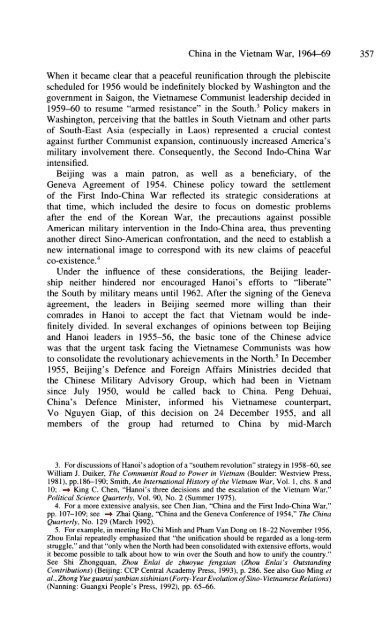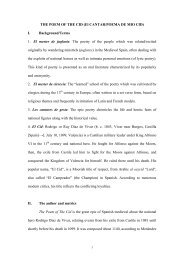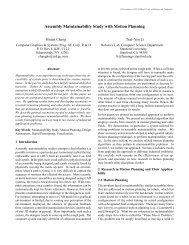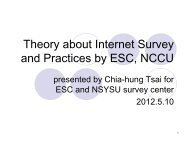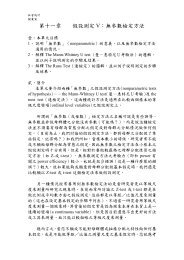<strong>Ch<strong>in</strong>a's</strong> <strong>Involvement</strong> <strong>in</strong> <strong>the</strong> <strong>Vietnam</strong> <strong>War</strong>,<strong>1964</strong>-<strong>69*</strong><strong>Chen</strong> <strong>Jian</strong>The <strong>Vietnam</strong> <strong>War</strong> was an <strong>in</strong>ternational conflict. Not only were <strong>the</strong>Americans engaged <strong>in</strong> large-scale military operations <strong>in</strong> a land far awayfrom <strong>the</strong>ir own, but <strong>the</strong> two major Communist powers, Ch<strong>in</strong>a and <strong>the</strong>Soviet Union, were also deeply <strong>in</strong>volved. In <strong>the</strong> case of Ch<strong>in</strong>a, scholarshave long assumed that Beij<strong>in</strong>g played an important role <strong>in</strong> support<strong>in</strong>gHanoi's efforts to fight <strong>the</strong> United States. Due to <strong>the</strong> lack of access toCh<strong>in</strong>ese source materials, however, <strong>the</strong>re have been difficulties <strong>in</strong> illustrat<strong>in</strong>gand def<strong>in</strong><strong>in</strong>g <strong>the</strong> motives, decision-mak<strong>in</strong>g processes, magnitudeand consequences of <strong>Ch<strong>in</strong>a's</strong> <strong>in</strong>volvement with <strong>the</strong> <strong>Vietnam</strong> <strong>War</strong>.1This article is based on Ch<strong>in</strong>ese sources available s<strong>in</strong>ce <strong>the</strong> late 1980s.As <strong>the</strong> cont<strong>in</strong>uation of an earlier study deal<strong>in</strong>g with <strong>Ch<strong>in</strong>a's</strong> connectionswith <strong>the</strong> First Indo-Ch<strong>in</strong>a <strong>War</strong>,2 it aims to shed some new lighton <strong>Ch<strong>in</strong>a's</strong> <strong>in</strong>volvement with <strong>the</strong> <strong>Vietnam</strong> <strong>War</strong>. It will cover <strong>the</strong> fivecrucial years from <strong>1964</strong> to 1969, pay<strong>in</strong>g particular attention to an analysisof <strong>the</strong> failure of an alliance that was once claimed "between bro<strong>the</strong>rlycomrades."Background: Ch<strong>in</strong>ese-North <strong>Vietnam</strong>ese Relations, 1954-62The Geneva agreement on Indo-Ch<strong>in</strong>a of 1954 concluded <strong>the</strong> FirstIndo-Ch<strong>in</strong>a <strong>War</strong>, but failed to end military conflicts <strong>in</strong> South-East Asia.*This article was orig<strong>in</strong>ally prepared for a Norwegian Nobel Institute research sem<strong>in</strong>ar on21 April 1993. The author benefited greatly from comments and suggestions by ThomasChristensen, John Garver, Melv<strong>in</strong> Leffler, Geir Lundestad, Anthony Short, R. B. Smith, JamesSommerville, Ste<strong>in</strong> Tonnesson, William Turley, Marilyn Young, Odd Arne Westad, AllenS. Whit<strong>in</strong>g and Zhang Shuguang. He is also grateful for <strong>the</strong> support of a Norwegian NobelInstitute fellowship and an NYS/UUP Dr. Drescher Leave Program fellowship.1. Despite <strong>the</strong> difficulties <strong>in</strong>volved <strong>in</strong> access<strong>in</strong>g Ch<strong>in</strong>ese sources, plausible studies do exist<strong>in</strong> <strong>the</strong> field. With privileged access to "<strong>in</strong>formation available to <strong>the</strong> author" draw<strong>in</strong>g on "hard<strong>in</strong>telligence," Allen S. Whit<strong>in</strong>g, <strong>in</strong> The Ch<strong>in</strong>ese Calculus of Deterrence: India and <strong>Vietnam</strong>(Ann Arbor: University of Michigan Press, 1975), ch. 6, draws an impressively accuratepicture, judged by new Ch<strong>in</strong>ese sources, of <strong>the</strong> scope and nature of <strong>Ch<strong>in</strong>a's</strong> <strong>in</strong>volvement with<strong>the</strong> <strong>Vietnam</strong> <strong>War</strong> from 1965 to 1968. In a recent article, "<strong>Ch<strong>in</strong>a's</strong> role <strong>in</strong> <strong>the</strong> <strong>Vietnam</strong> <strong>War</strong>,"(<strong>in</strong> Jayne Werner and David Hunt (eds.), The American <strong>War</strong> <strong>in</strong> <strong>Vietnam</strong> (Ithaca: CornellUniversity Sou<strong>the</strong>ast Asia Program, 1993), pp. 71-76), Whit<strong>in</strong>g fur<strong>the</strong>r checks <strong>the</strong>conclusions of his study <strong>in</strong> light of <strong>the</strong> op<strong>in</strong>ion of <strong>Vietnam</strong>ese scholars. The first three volumesof R. B. Smith's comprehensive study, An International History of<strong>the</strong> <strong>Vietnam</strong> <strong>War</strong> (London:Macmillan, 1983-91), offer an excellent treatment of <strong>the</strong> <strong>in</strong>ternational dimension of <strong>the</strong> war,<strong>in</strong>clud<strong>in</strong>g <strong>the</strong> Ch<strong>in</strong>ese connection. Useful <strong>in</strong>formation and plausible analyses can also befound <strong>in</strong> William J. Duiker, Ch<strong>in</strong>a and <strong>Vietnam</strong>: The Roots of Conflict (Berkeley: Instituteof East Asian Studies, 1986); Robert S. Ross, The Indoch<strong>in</strong>a Tangle: <strong>Ch<strong>in</strong>a's</strong> <strong>Vietnam</strong> Policy,1975-1979 (New York: Columbia University Press, 1988); and Anne Gilks, The Breakdownof <strong>the</strong> S<strong>in</strong>o-<strong>Vietnam</strong>ese Alliance, 1970-1979 (Berkeley: Center for Ch<strong>in</strong>ese Studies, 1992).2. <strong>Chen</strong> <strong>Jian</strong>, "Ch<strong>in</strong>a and <strong>the</strong> First Indo-Ch<strong>in</strong>a <strong>War</strong>, 1950-54," The Ch<strong>in</strong>a Quarterly, No.133 (March 1993), pp. 85-110.? The Ch<strong>in</strong>a Quarterly, 1995
Ch<strong>in</strong>a <strong>in</strong> <strong>the</strong> <strong>Vietnam</strong> <strong>War</strong>, <strong>1964</strong>-69 357When it became clear that a peaceful reunification through <strong>the</strong> plebiscitescheduled for 1956 would be <strong>in</strong>def<strong>in</strong>itely blocked by Wash<strong>in</strong>gton and <strong>the</strong>government <strong>in</strong> Saigon, <strong>the</strong> <strong>Vietnam</strong>ese Communist leadership decided <strong>in</strong>1959-60 to resume "armed resistance" <strong>in</strong> <strong>the</strong> South.3 Policy makers <strong>in</strong>Wash<strong>in</strong>gton, perceiv<strong>in</strong>g that <strong>the</strong> battles <strong>in</strong> South <strong>Vietnam</strong> and o<strong>the</strong>r partsof South-East Asia (especially <strong>in</strong> Laos) represented a crucial contestaga<strong>in</strong>st fur<strong>the</strong>r Communist expansion, cont<strong>in</strong>uously <strong>in</strong>creased America'smilitary <strong>in</strong>volvement <strong>the</strong>re. Consequently, <strong>the</strong> Second Indo-Ch<strong>in</strong>a <strong>War</strong><strong>in</strong>tensified.Beij<strong>in</strong>g was a ma<strong>in</strong> patron, as well as a beneficiary, of <strong>the</strong>Geneva Agreement of 1954. Ch<strong>in</strong>ese policy toward <strong>the</strong> settlementof <strong>the</strong> First Indo-Ch<strong>in</strong>a <strong>War</strong> reflected its strategic considerations atthat time, which <strong>in</strong>cluded <strong>the</strong> desire to focus on domestic problemsafter <strong>the</strong> end of <strong>the</strong> Korean <strong>War</strong>, <strong>the</strong> precautions aga<strong>in</strong>st possibleAmerican military <strong>in</strong>tervention <strong>in</strong> <strong>the</strong> Indo-Ch<strong>in</strong>a area, thus prevent<strong>in</strong>gano<strong>the</strong>r direct S<strong>in</strong>o-American confrontation, and <strong>the</strong> need to establish anew <strong>in</strong>ternational image to correspond with its new claims of peacefulco-existence.4Under <strong>the</strong> <strong>in</strong>fluence of <strong>the</strong>se considerations, <strong>the</strong> Beij<strong>in</strong>g leadershipnei<strong>the</strong>r h<strong>in</strong>dered nor encouraged Hanoi's efforts to "liberate"<strong>the</strong> South by military means until 1962. After <strong>the</strong> sign<strong>in</strong>g of <strong>the</strong> Genevaagreement, <strong>the</strong> leaders <strong>in</strong> Beij<strong>in</strong>g seemed more will<strong>in</strong>g than <strong>the</strong>ircomrades <strong>in</strong> Hanoi to accept <strong>the</strong> fact that <strong>Vietnam</strong> would be <strong>in</strong>def<strong>in</strong>itelydivided. In several exchanges of op<strong>in</strong>ions between top Beij<strong>in</strong>gand Hanoi leaders <strong>in</strong> 1955-56, <strong>the</strong> basic tone of <strong>the</strong> Ch<strong>in</strong>ese advicewas that <strong>the</strong> urgent task fac<strong>in</strong>g <strong>the</strong> <strong>Vietnam</strong>ese Communists was howto consolidate <strong>the</strong> revolutionary achievements <strong>in</strong> <strong>the</strong> North.5 In December1955, Beij<strong>in</strong>g's Defence and Foreign Affairs M<strong>in</strong>istries decided that<strong>the</strong> Ch<strong>in</strong>ese Military Advisory Group, which had been <strong>in</strong> <strong>Vietnam</strong>s<strong>in</strong>ce July 1950, would be called back to Ch<strong>in</strong>a. Peng Dehuai,<strong>Ch<strong>in</strong>a's</strong> Defence M<strong>in</strong>ister, <strong>in</strong>formed his <strong>Vietnam</strong>ese counterpart,Vo Nguyen Giap, of this decision on 24 December 1955, and allmembers of <strong>the</strong> group had returned to Ch<strong>in</strong>a by mid-March3. For discussions of Hanoi's adoption of a "sou<strong>the</strong>m revolution" strategy <strong>in</strong> 1958-60, seeWilliam J. Duiker, The Communist Road to Power <strong>in</strong> <strong>Vietnam</strong> (Boulder: Westview Press,1981), pp.186-190; Smith, An International History of <strong>the</strong> <strong>Vietnam</strong> <strong>War</strong>, Vol. 1, chs. 8 and10; and K<strong>in</strong>g C. <strong>Chen</strong>, "Hanoi's three decisions and <strong>the</strong> escalation of <strong>the</strong> <strong>Vietnam</strong> <strong>War</strong>,"Political Science Quarterly, Vol. 90, No. 2 (Summer 1975).4. For a more extensive analysis, see <strong>Chen</strong> <strong>Jian</strong>, "Ch<strong>in</strong>a and <strong>the</strong> First Indo-Ch<strong>in</strong>a <strong>War</strong>,"pp. 107-109; see also Zhai Qiang, "Ch<strong>in</strong>a and <strong>the</strong> Geneva Conference of 1954," The Ch<strong>in</strong>aQuarterly, No. 129 (March 1992).5. For example, <strong>in</strong> meet<strong>in</strong>g Ho Chi M<strong>in</strong>h and Pham Van Dong on 18-22 November 1956,Zhou Enlai repeatedly emphasized that "<strong>the</strong> unification should be regarded as a long-termstruggle," and that "only when <strong>the</strong> North had been consolidated with extensive efforts, wouldit become possible to talk about how to w<strong>in</strong> over <strong>the</strong> South and how to unify <strong>the</strong> country."See Shi Zhongquan, Zhou Enlai de zhuoyue fengxian (Zhou Enlai's Outstand<strong>in</strong>gContributions) (Beij<strong>in</strong>g: CCP Central Academy Press, 1993), p. 286. See also Guo M<strong>in</strong>g etal., Zhong Yue guanxi yanbian sish<strong>in</strong>ian (Forty- Year Evolution ofS<strong>in</strong>o- <strong>Vietnam</strong>ese Relations)(Nann<strong>in</strong>g: Guangxi People's Press, 1992), pp. 65-66.
- Page 1: China's Involvement in the Vietnam
- Page 5 and 6: China in the Vietnam War, 1964-69 3
- Page 7 and 8: China in the Vietnam War, 1964-69 3
- Page 9 and 10: China in the Vietnam War, 1964-69 3
- Page 11 and 12: China in the Vietnam War, 1964-69 3
- Page 13 and 14: China in the Vietnam War, 1964-69 3
- Page 15 and 16: China in the Vietnam War, 1964-69 3
- Page 17 and 18: China in the Vietnam War, 1964-69 3
- Page 19 and 20: China in the Vietnam War, 1964-69 3
- Page 21 and 22: China in the Vietnam War, 1964-69 3
- Page 23 and 24: China in the Vietnam War, 1964-69 3
- Page 25 and 26: Table 1: China's Military Supply to
- Page 27 and 28: China in the Vietnam War, 1964-69 3
- Page 29 and 30: China in the Vietnam War, 1964-69 3
- Page 31 and 32: China in the Vietnam War, 1964-69 3
- Page 33: China in the Vietnam War, 1964-69 3


